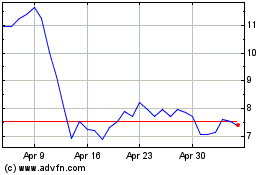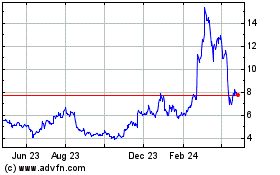Uniswap Who? Trader Joe’s AMM Takes DeFi By Storm
April 07 2023 - 6:00PM
NEWSBTC
In the fast-evolving world of decentralized finance (DeFi), new
players are constantly emerging with innovative solutions to
address the challenges of trading and liquidity provision. One
platform that has been making waves in the DeFi ecosystem is Trader
Joe, which has gained steam with its capital-efficient
decentralized exchange (DEX). According to a recent Twitter
post by Chase, a researcher at Messari, the heart of Trader Joe’s
success is its Liquidity Book (LB), a concentrated liquidity model
that is being hailed as a game-changer for liquidity providers in
the DeFi space. Related Reading: DYDX Tumbles 5% As
Ethereum-Based DEX Wind Down Operations What Makes Trader Joe
Different From Other DeFi Protocols? Competing with established
players like Uniswap V3, Trader Joe’s LB is quickly gaining
traction, being the fastest-growing DEX over the last 180 days. The
platform’s surging growth is a testament to its appeal to traders
and liquidity providers. Trader Joe and Uniswap are decentralized
exchanges allowing users to trade cryptocurrencies without relying
on centralized intermediaries. However, there are several key
differences between the two platforms: Liquidity Model: Trader
Joe’s uses a concentrated liquidity model called the Liquidity
Book, as said before, while Uniswap uses a constant product market
maker model. The LB can be more capital-efficient and
cost-effective for liquidity providers, while the construct product
model is simpler and more widely used in the DeFi ecosystem.
Furthermore, its LB is a liquidity provision model developed by
Trader Joe’s. It allows liquidity providers to concentrate their
funds in a specific price range rather than spreading them out
across the entire price spectrum. Additionally, the LB can be
more cost-effective for smaller liquidity providers, who may not
have the capital to provide liquidity across the entire price
spectrum on other Automatized Market Makers (AMMs) Fees: Trader
Joe’s charges lower fees than Uniswap. This can make it more
attractive to traders and liquidity providers looking to minimize
costs. Development: Trader Joe’s is community-driven,
allowing users to propose and vote on changes on the platform. On
the other hand, Uniswap is governed by a protocol controlled by a
small group of stakeholders. Keys Behind Trader Joe’s Current
Success In DeFi According to Chase, one key factor behind
this success is Joe V2’s higher base fees. This means liquidity
providers earn more fees on every trade in the pool. Joe V2 adds a
volatility fee, further increasing liquidity providers’
profitability. According to data compiled by Chase, 36.5% of
Joe V2’s WETH-USDC liquidity on Arbitrum falls within the +/- 2%
price range, significantly higher than the 19.9% for Uniswap V3 and
the 4% for SushiSwap. This concentration of liquidity is likely
driven by the lower liquidity provider management costs on Joe V2
compared to Uniswap V3. Despite the success of Trader Joe’s
V2 pools regarding liquidity provider profitability and liquidity
concentration, the platform still faces significant competition
from established players like UniSwap. Per the researcher,
over the last 2 weeks, UniSwap V3 has averaged $10 million in daily
ARB-ETH volumes from 1inch, while Joe V2 has only averaged $9,800.
Chase claims that to compete with UniSwap and attract more trading
volumes, Joe V2 must either cut its fees or grow its
liquidity. As of this writing, the circulating market
capitalization of Uniswap is worth over $4.5 billion, down 2% in
the last few days. In contrast, Trader Joe’s market cap is
currently at $195 million, with a trading volume of $29 billion.
This is significantly lower than Uniswap’s trading volume, which is
$831 billion. Despite the differences between Trader Joe and
Uniswap, the fast growth of Trader Joe, and the continued dominance
of Uniswap in the decentralized exchanges (DEX), the DeFi ecosystem
seems poise to grow. Competition and further innovations in the
ecosystem can attract more users and investors to the nascent
industry and its technologies. Related Reading: Cardano (ADA) Takes
A Step Closer To Full Decentralization, Here’s How Featured image
from Unsplash, chart from TradingView.com
Uniswap (COIN:UNIUSD)
Historical Stock Chart
From Aug 2024 to Sep 2024

Uniswap (COIN:UNIUSD)
Historical Stock Chart
From Sep 2023 to Sep 2024
